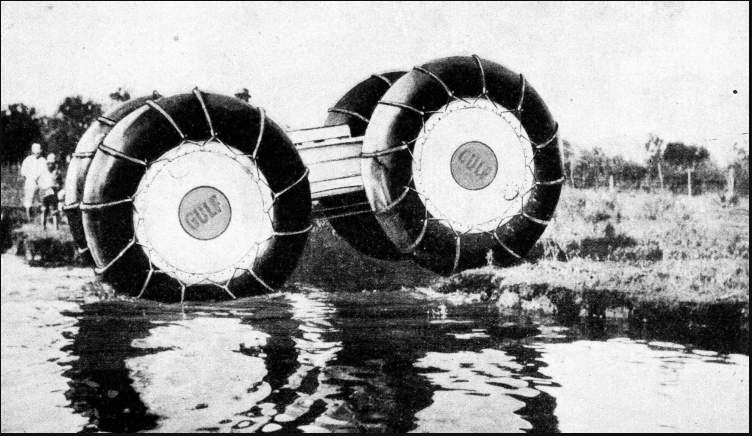|
|
One of the most ingenious vehicles developed for engineering purposes is the marsh buggy, which is used in the swamp lands of Louisiana, U.S.A. It travels over roads as a motor car, through swamps as a tractor, and in the water as a boat. When afloat it develops a speed of a little more than six knots. A folding bowsprit and collapsible mast carry the lights necessary for inland water navigation. In swamps and on marshy ground its speed is from ten to twelve miles an hour. On smooth and level ground it reaches a speed of about thirty-five miles an hour. The need for a machine of such unusual versatility arose when geologists predicted that the coastal swamps of Louisiana might have great potential value as a centre for oilfields. Prospectors could not survey this difficult region without some special means of transport for their instruments, and the marsh buggy was evolved to carry the instruments and a surveying platform. Reeds, growing as much as twelve feet above the water of the swamps, were one of the reasons why a surveying platform was essential. The marsh buggy, illustrated below (without its platform) comprises an aluminium chassis and four aluminium wheels of 5 ft. 6 in. diameter, to which are fitted large balloon tyres. The tyres, ten feet in diameter and about three feet wide, are inflated to a pressure of from 3 lb. to 5 lb. per square inch. On land they make springs unnecessary ; in the water they give the marsh buggy, which weighs 7,500 lb., or nearly three and a half tons, a draught of less than two feet. Ingenious arrangements have been devised to counter the effects of punctures in the varied conditions in which the buggy may be placed. The aluminium wheels are made in the form of hollow drums, which are watertight and sufficiently buoyant to keep the marsh buggy afloat even with all its tyres deflated. In the event of a puncture occurring while the vehicle is traversing swampy land, the tyre is kept inflated by an air compressor--connected to the tyre through the hub of the wheel--until dry land is reached. The power unit, a Ford V8 engine, is fitted with an ordinary gearbox in series with a tractor gearbox, driving the rear wheels. The front wheels are driven by chains from the back axles. The transmission includes the usual back-axle differential and two brake clutches. One of these is for the nearside and the other for the offside pair of wheels, so that in the water the marsh buggy can be steered to port or to starboard by using the appropriate pair of wheels, or it can be steered straight forward by using all four wheels. On land the steering is much the same as that for a motor car; but the front axle is pivoted, enabling either of the front wheels to rise as much as two feet above the other without tilting the chassis. The total number of speeds provided for in the combined gearboxes is sixteen--ten forward and six reverse. In front, facing the driver, is a vertical control panel with the usual instruments, as well as a compass and water temperature indicator. A short-wave radio transmitter and receiver are provided to enable the machine to keep in touch with its base.
Many thanks for your help
|
   Share this page on Facebook - Share  [email protected] |





